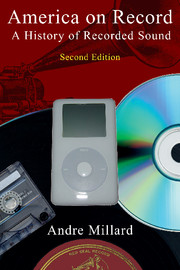Book contents
- Frontmatter
- Dedication
- Contents
- Preface to the second edition
- Preface to the first edition
- Introduction
- Part One The acoustic era
- 1 The inventors
- 2 A phonograph in every home
- 3 The international industry of recorded sound
- 4 The music
- 5 Recorded sound in the Jazz Age
- Part Two The electrical era
- Part Three The digital era
- Abbreviations used in the notes
- Notes
- Select discography
- Select bibliography
- Subject index
- Recordings index
- Motion picture index
3 - The international industry of recorded sound
from Part One - The acoustic era
Published online by Cambridge University Press: 05 February 2015
- Frontmatter
- Dedication
- Contents
- Preface to the second edition
- Preface to the first edition
- Introduction
- Part One The acoustic era
- 1 The inventors
- 2 A phonograph in every home
- 3 The international industry of recorded sound
- 4 The music
- 5 Recorded sound in the Jazz Age
- Part Two The electrical era
- Part Three The digital era
- Abbreviations used in the notes
- Notes
- Select discography
- Select bibliography
- Subject index
- Recordings index
- Motion picture index
Summary
The period from 1900 to 1920 marked the high point in the fortunes of the talking machine. With a small interruption caused by the depression of 1907, each succeeding year of the twentieth century brought higher sales. A record player stood proudly in the sitting rooms of millions of Americans, and there was little to challenge its position as the leading form of home entertainment. Where once only the upper classes could enjoy fine music, usually in the form of a piano, now everybody could afford it. The phonograph had ushered in the age of mechanical entertainment in America, and it was to prepare the ground for many other high-tech entertainers in the future.
The Big Three had succeeded in the daunting task of mass-producing complex machines and pressing millions of exact duplicates of recordings. They had built massive industrial plants. Their interests ranged from stockpiles of chemicals used in their records to contracts with well-known musicians and singers. They had recorded some of the world's greatest musical figures and made a permanent record of their art.
Each of the Big Three did millions of dollars of business each year. In 1914 the U.S. census found that there were eighteen manufacturing establishments in the industry with a total value of output that exceeded $27 million. Of this total $4 million was accounted for by Edison and $16 million by Victor.
Edison, Victor, and Columbia held almost every important patent for talking machines and records. The legal battles among them slowly grew less violent and disruptive in the second decade of the twentieth century, although Victor did its best to prosecute those who had infringed on its Victrola patents. The entry of Edison into the disc market in 1913 did not bring the legal battle that his lawyers had feared: the Edison Diamond Disc player was not too blatant a copy of the Victrola, and it did not threaten Victor's sales.
- Type
- Chapter
- Information
- America on RecordA History of Recorded Sound, pp. 65 - 79Publisher: Cambridge University PressPrint publication year: 2005



